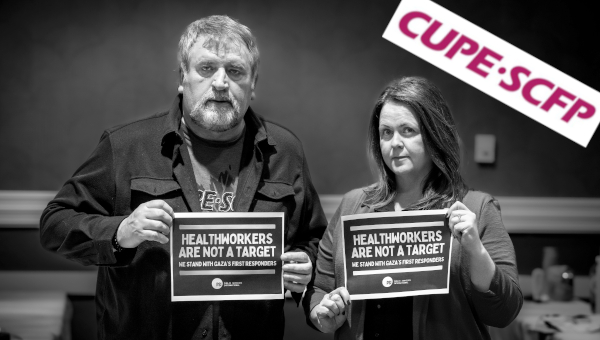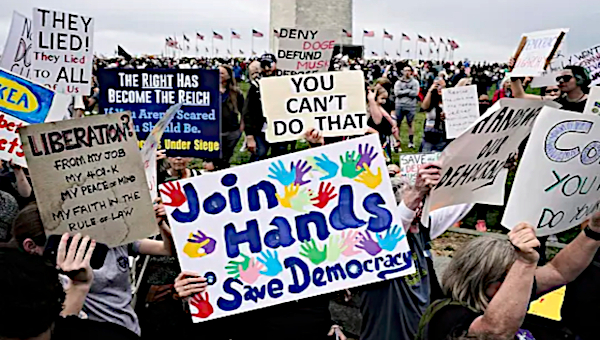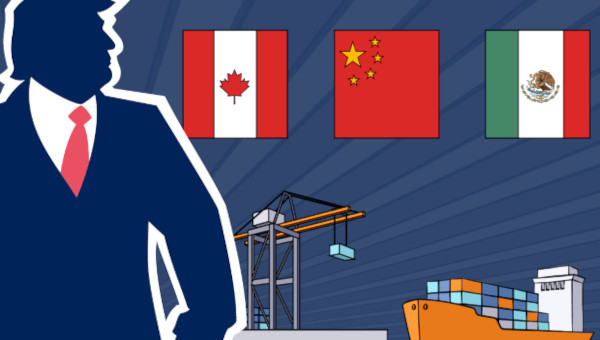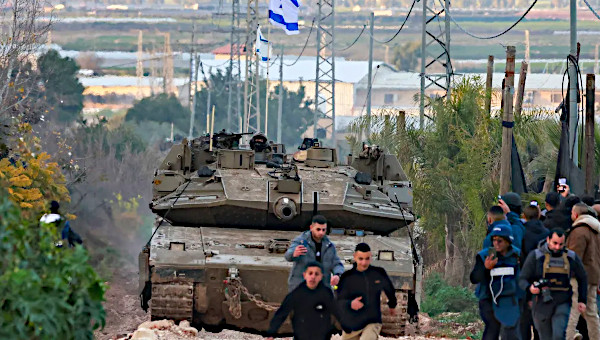‘Ask Afghans what would help them, don’t ask Karzai’
Mike Skinner, co-founder of the Afghanistan-Canadian Research Group and a researcher at the York Centre for International and Security Studies in Toronto, believes a simple question is being left out of the debate about Canada’s continued military involvement in Afghanistan: ”Why are we there?” It is a no-brainer to ask this but there are no easy answers it appears.
To understand the goals of Canada’s role, he said, we need to examine the forms of intervention under current consideration as alternatives to Ottawa’s combat mission in Kandahar. During extensive travels in Afghanistan in 2007, Skinner studied firsthand Canada’s intervention, assisted by Afghan-Canadian reporter Hamayon Rastgar, and has written widely on this question. The two men formed, along with fellow-researcher Angela Joya, the Afghanistan-Canadian Research Group.
When considering the example of Canada’s supposed “humanitarian” aid projects, which the New Democratic Party and the Bloc Québécois propose as an alternative to a military mission, Skinner emphasises the limitations of the approach and the bad feelings it can engender.
“Canadian aid agencies in Afghanistan have to follow the orders of the military,” he says. “Aid is meted out as rewards to co-operative communities and withdrawn from others as punishment.”
It was not always the case. “Canadian development and aid agencies – like Care Canada and the Red Cross – had been working in Afghanistan, through all the upheavals in government, the Soviet occupation, and then, after 1992, the Mujahedeen period, and, after 1996, under the Taliban regime. They operated in very difficult conditions, negotiating with the government in power,” Skinner says.
NGOs Conscripted to Military Service
“In 2008, these organizations were told that humanitarian operations had to serve military purposes. If they did not, they would be in ‘very threatening circumstances,’” Skinner says. In effect, the non-governmental organizations were constrained to become part of the U.S. military’s counterinsurgency program.
NGOs also were imperilled by “special ops” – secret strike forces of the Canadian and U.S. armies. “U.S. special forces have impersonated NGO workers, posing as civilians,” Skinner says. When fighters resisting the U.S.-led occupation see this, all NGO workers become suspect in their eyes.

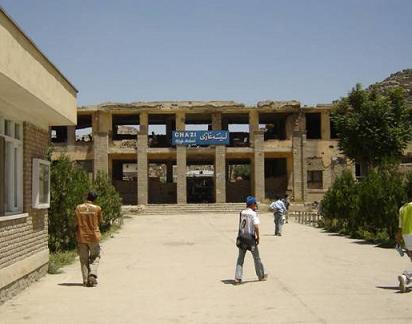
The Ghazi High School, in Kabul.
“NGOs began protesting against these practices as early as 2004.” In 2008, “many NGOs, including Care Canada and the Red Cross, pulled out from conflict zones in Afghanistan.”
Under the Obama presidency, U.S. military control of “humanitarian aid” was heightened. Eight NGOs including Care and OXFAM criticized the use of “aid as a weapons system” in a joint statement released in January 2010. In February, United Nations aid officials refused to co-operate with U.S.-led military operations, which the UN officials describe as the “militarization” of Afghan Aid.
In the early stages of the war, the occupation of Afghanistan consisted of two separate operations, Skinner explains. “There was OEF (Operation Enduring Freedom) – the original invasion carried out by the Anglo-Saxon states: the U.S., Britain, Canada, and Australia.” OEF, organized under the umbrella of GWOT (Global War on Terror), operates worldwide: it directs the war in Somalia and the decades-old U.S. involvement in civil conflicts in the Philippines. Ominously, OEF/GWOT started up operations in 2008 in the Caribbean and Central America.
“A second parallel mission, sanctioned by the United Nations and under NATO leadership, is the International Security and Assistance Force (ISAF), which is supposed to conduct ‘peace’ operations and help stabilize the Hamid Karzai government. But Obama rolled both operations into one under the command of General David Petraeus,” strengthening U.S. military control of “aid” projects.
‘Training’ For What?
As for the military ‘training’ mission favoured by the Conservative and Liberal parties, Skinner asks, “just what are we training Afghan soldiers to do?”
Here we must examine, he said, the record of U.S. training missions around the world in recent decades. “They have immense experience around the world, in the Vietnam war, elsewhere in southeast Asia, and in Latin America. This ‘training’ has had devastating results for the people of these regions.”
The U.S. military have ‘trained’ more than 60,000 Latin American soldiers in their notorious Fort Benning, Georgia, School of the Americas, now renamed WHINSEC (Western Hemisphere Institute for Security Co-operation). The school’s alumni include prominent supporters of rightist military coups, repression, torture, and killings directed against democratic movements.
The U.S. and its allies have been ‘training’ Afghan soldiers for almost a decade, Skinner noted. “What is this army for? Simply to control the population by military means,” he suggests. The intent is to ensure that people will consent to massive projects to extract and ship raw materials, which will displace large numbers of residents – “like in North America in the 18th and 19th centuries, except that now extermination is not an acceptable option.”
Secret Military Operations
Unmentioned in the present debate on Canada’s Afghanistan involvement is its Special Operations forces – the 600-member JTF 2 (Joint Task Force Two) and two recently formed units. Such elite units carry out special strike missions, “avoiding any kind of accountability.”
“They are never mentioned in the press or official documentation. Are they operating with the U.S. in covert actions in Pakistan? Probably. But a member of parliament can’t get an answer to that question.”
When Canada ends its “combat mission” in Afghanistan next year, will JTF 2 and other special ops groups be withdrawn? Not necessarily. “It’s not clear,” said Skinner
A Worm’s Eye View of the Occupation
During his 2007 travels in Afghanistan, Skinner interviewed more than a hundred Afghans on their view of the occupation – intellectuals, farmers, miners, university students, shopkeepers, and human rights activists.
“Afghans don’t see Canada’s involvement as a sudden rush to their aid. Their urgent needs – fresh water, sanitation, basic infrastructure, electricity, telephone – they see little of that. Instead, they see construction of infrastructure for large-scale commercial development,” he notes.
“They are sceptical of electrical development, for example, which is more likely to provide power for smelters, not meet people’s needs.”
Canada’s signature development project, he said, was the rebuilding of a dam in the Helmand river valley – repairing a U.S.-sponsored development project of the 1950s that had a devastating impact on local farmers and the environment. The repair project “has now been apparently abandoned – a boondoggle for SNC-Lavalin,” the major contractor.
Opinion polls in Afghanistan have shown a majority against the invasion of the country, Skinner adds.
Opening Afghanistan for Capitalism
“What was the goal of the invasion?” Skinner asks. “Liberation of women? If that was the goal, it has failed. Build the state? A failure. But on other issues, the invasion has been very successful, and Afghans are quite perceptive of this.”
Afghanistan is “important real estate,” Skinner says. “It sits astride the shortest route between China and Europe, between India and Russia.” Iran, China, and Turkey are all active in Afghanistan, “and they have great economic and social advantages over the Western countries.”
The U.S.-led invasion is part of a two-track policy articulated in the 2008 U.S. National Defense Strategy. The first and preferred track, Skinner notes, is to engage China and Russia within the globalization of capitalism. Failing this, the second track is a “containment policy reminiscent of the Cold War. Occupying Afghanistan serves both purposes of engagement and potential containment.” Previously, “Afghanistan was cut off as a buffer zone; today it is a bridgehead into Eurasia.” For the invading powers human welfare is secondary to the “opening up of Afghanistan to capitalist development.”
What Should Canada Do?
In Skinner’s opinion, under present conditions – foreign occupation, all-out war, and a puppet government – none of the forms of involvement now being considered by Canada’s political parties will serve the needs of the Afghan people.
What should Canada do? “Ask Afghans what would help them. Don’t ask Karzai, ask the people. That is easy to say but hard to do. We need to open up communications with Afghan organizations on the ground.” There are many such organizations, isolated by the language barrier and silenced by repression. “We have a task here of human solidarity.”
But the first step, Skinner says, is clear: “The Canadian state needs to dissociate itself from the U.S. imperial project in Afghanistan – fully and completely.” •
John Riddell is a Toronto-based activist and co-editor of Socialist Voice. This article was first published in rabble.ca.
Afghanistan War: The Crucible for Reorienting Canadian Foreign Policy
David McKee
Operation Apollo, Operation Athena, Operation Archer, Operation Accius, Operation Altair … since Canada first entered the war on Afghanistan in 2001 the list of extensions, renewals and “spin-offs” has gone on and on and on. Originally scheduled to end in 2003, Canada’s involvement in this imperialist aggression threatens to continue until 2014 if Prime Minister Stephen Harper gets his way.

Afghanistan has been the central preoccupation of Canadian foreign policy over the past decade. It has also been a main focus of peace movement activity. Mobilizations against the war in Afghanistan have not been nearly as spectacular as those against the invasion of Iraq in 2003. The build up was slower, and it took more time to locate a basis of unity upon which to build mobilizations.
But, for the entire decade, opinion polls have repeatedly shown that a majority of Canadians disagree with the war. Despite massive spending on huge PR campaigns to “sell” the war to the public, and the constant ideological bombardment from the government, the military and its allied industries, and the corporate media, Canadians remain opposed to this war.
Yet successive Canadian governments (both Liberal and Conservative) have pursued a policy of war. Clearly, the state has an interest in the Afghanistan war that surpasses (and diminishes) the electoral concerns of any individual party or government. Examining and understanding this interest is key to strengthening both the anti-war effort and the broader movement for peace and progress.
Not A Localized Conflict
The advanced sections of the peace movements have long understood that the war in Afghanistan was never a localized conflict. From the get-go, it was part of a regional campaign that includes the war against Iraq and Israel’s role in the Middle East.
To overly simplify the situation, the war in Afghanistan was a key component in the drive by the United States (and its Canadian and British allies) to recolonize a huge, resource-rich area of the world. While this view is quite correct, it is obviously a truncated assessment of a much more complicated issue.
A related way of looking at things is to view the war in Afghanistan as the crucible in which a new direction in Canadian foreign policy is being tested and clarified. There are a number of elements to this policy shift:
- a deliberate and dramatic shift away from UN-oriented multilateralism toward an “ad-hoc” multilateralism. (There are many problems with the United Nations, but to replace it with makeshift “coalitions of the willing” is nothing short of gangster politics on a global scale);
- a heightened emphasis on NATO and identifying a new role for that military alliance;
- a definite move away from “traditional peacekeeping” (again, there are plenty of problems with this role and these missions, but Canada is certainly not moving toward an improved model);
- a more aggressive posture in foreign policy, with greater emphasis on military action, sanctions, terror lists, etc., instead of development, diplomacy, cooperation, and peace;
- a more brash statement of Canadian economic interests as key to foreign policy developments.
These changes are deeply at play in Canada’s involvement in Afghanistan. Perhaps the clearest example is the Canada First Defence Strategy (CFDS), the Harper government’s blueprint for defence and foreign policy. The following excerpts from a 2008 Canadian Peace Congress statement on CFDS provide a sense of the scope of the reorientation in Canadian foreign policy, how tightly related it is to the war in Afghanistan, and the profound implications it has for domestic policy:
“CFDS is the manifesto of the most aggressive circles of Canadian finance capital seeking with a bigger military budget to strengthen its influence at the round tables in Washington and Brussels.
“The CFDS flaunts military power as the essential ingredient of Canadian diplomacy in international affairs. CFDS promotes the growth, modernization and combat readiness of the Canadian military and its interoperability with U.S. military forces for one main reason, to commit Canada to current and future U.S.-NATO wars, interventions and occupations as the first principle of Canadian government foreign policy. CFDS boasts of the experience gained by Canadian forces in Afghanistan as a `military that can operate far from home on a sustained basis.’ According to Prime Minister Harper the ability to wage war is the path that will return Canada to the international stage as a `credible and influential country.’
“CFDS elevates commitments to NATO, NORAD, ORTHCOM, the Security and Prosperity Partnership (SPP) and the Civil Assistance Plan, the latter permitting U.S. troops on Canadian soil in the event of a `civil emergency,’ above all other Canadian international obligations and treaties. As such CFDS actually weakens Canadian sovereignty by subordinating Canadian defense policy to the global military strategy of the U.S. and NATO.
“Fear-mongering about alleged threats to Canadian security is the method used by the Conservative government to justify massive transfers of public finances, without Parliamentary approval, to foreign and domestic defence speculative expansion of the economy. This is what is meant by the `military partnership with Canadian industry.’
“CFDS is profoundly undemocratic and was implemented without seeking Parliamentary approval and commits $492-billion over 20 years on top of the $5.3-billion already allocated in 2006, approaching 2.2% of GDP, all to guarantee the profits of defence contractors and investors. The Canadian government policy of the rapid militarization of the economy is the only job creation project the Government has to offer youth, the unemployed and the under-employed. CFDS cannot be implemented without sacrificing the needs of public health care, pensions, childcare, seniors’ needs, low cost housing and the peaceful development of the country.”
To understand why the state is so committed to this sweeping reorientation of Canadian foreign policy, it is useful to review events of the past two decades.
In the early 1990s, Canada experienced a huge economic recession, exacerbated by “free trade.” The comprehensive restructuring of the Canadian economy meant that some entire sectors were decimated, while some new sectors of Canadian capital emerged and grew. Globalization in general (related to huge developments in technology) was on the rise, sparking extensive discourse about how to reorient in order to identify and exploit new global opportunities.
But the central development at this time was the sudden, unexpected collapse of the USSR and massive geopolitical changes which followed. Huge areas of the world were now “opened up” to Western capitalism (whose members were fighting amongst themselves for key positions – for a slice of the pie). At the same time, the end of the Cold War meant the sudden loss of NATO’s raison d’être. NATO embarked on a long search for a new identity and role, taking it to the war on Yugoslavia (which, at least immediately, was a disaster in terms of consolidating Western states around a new role for the alliance).
A key moment in the “post-Soviet” era policy debates is represented by the 1999 Symposium of the Conference of Defence Associations. The CDA advocacy group, whose membership is made up of over 50 military organizations, is large, well-funded and well-connected. Part of its funding comes from the Department of National Defence, so when CDA speaks, DND listens.
The 1999 symposium was focused on changing strategic assessment within the context of massive geopolitical shifts. Specifically, the symposium identified the following strategic issues:
- the pressing need for reorientation in Canadian foreign policy (military and economic) in light of the collapse of the USSR;
- the rise of China as a political and economic world power, a rise characterized as “the most serious challenge to Western interests in the Pacific”;
- the importance of retaining and developing NATO as a counter-balance to changing geopolitics that challenge Western interests;
- the destabilization of the central Asian states as a strategic and economic opportunity, and specific opportunities for Canada in the vast energy reserves of the central Asian region;
- the necessity for Canada to integrate military and economic issues within foreign policy discussions, in order to exert global influence and reap economic benefit;
- the government of Iraq – characterized as a “rogue state” as a barrier to securing Western interests in the central Asian region.
Virtually every one of these concerns have assumed a central place in Canadian foreign policy over the past ten years, and every one has been addressed to significant extents in the arena of the war on Afghanistan.
The Canadian state uses the war to justify, implement, test and clarify new foreign policy directions whose scope ranges far beyond that one country. For this reason, the stakes are critically high for a government that seeks to extend the war. By the same token, when the peace and anti-war movements confront the war in Afghanistan, we are engaged in a much more profound struggle, one that ultimately has a decisive role in determining our country’s role in the world. Mobilization against the war must continue – it is the war that must end, now. •
David McKee is President of the Canadian Peace Congress. First published in People’s Voice, December 1-15, 2010.


